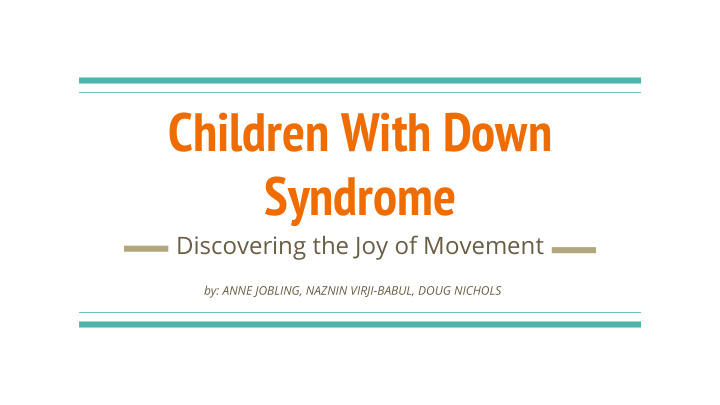



Children With Down Syndrome Discovering the Joy of Movement by: ANNE JOBLING, NAZNIN VIRJI-BABUL, DOUG NICHOLS
What is Down Syndrome and How Does it Affect Physical Education? - It results from the presence of a full or partial extra 21st chromosome. - This disrupts the individual's mental, physical and social development. - It also causes problems with understanding movement patterns and the development of movement proficiency is a slow, frustrating process. - The movement style is often described as being “clumsiness”
What is This “Clumsiness”? This observable movement quality is caused by the individual's understanding of movement and physical capabilities. - Movement sequences are seen as many separate tasks causing the sense of jerkiness or “clumsiness” - ““Poor postural stability and balance, as well as increases in postural stiffness, are considered to be contributing factors to these problems” (Jobling & Mon- Williams, 2000; Webber, Virji-Babul, Edwards, & Lesperance, 2004)” (p. 34) - ““Strength and reaction times are also important factors in controlling body movement” (Parker, Monsoon, & Larkin, 1993)” (p. 34).
What is Happening Now in the Physical Education? - Therapies and physical education is focused on skill attainment - Very little creative movement or creative play is occurring in the movement therapies. - Individuals with Down Syndrome are not being taught to love moving.
Is Dance the Solution? “(Dupont and Schulmann) (1987) suggested that dance, with its elements of kinaesthetic awareness and visual representations of movements, can accommodate the children’s learning styles. Also, the “inherent practice and rehearsal effects could remediate deficits in postural control and make practicing a motivating and rewarding experience for children” (Dupont & Schulmann, p. 11).” (p. 35) “Dunphy and Scott (2003) have also presented dance as a valuable form of movement-skill development and expression, and reinforced the earlier notion that Laban’s core concepts should be used to frame dance education for individuals with intellectual disabilities” (p. 35)
What are They Suggesting? Rudolph Laban’s Framework for movement could be a means of educating those with Down Syndrome. “The authors of this article believe that the use of Laban’s core concepts of movement in a creative dance program can cultivate specific aspects inherent in moving and that the use of the associated movement words can greatly facilitate the learning and understanding of movement by children with DS“ (p. 36). So, Rudolph Laban’s elements of dance may allow those with Down Syndrome to understand and master movement concepts and even use movement as a means of expression.
Who is Rudolph Laban and What is He All About? - Rudolph Laban established the core elements of dance. - He created a notation system that allowed individuals to write and record dances on paper. - He provided specific vocabulary to discuss the different elements of dance. - Laban was a pioneer in dance education and teaching creative movement. - Four core elements are body, effort, shape/relationships and space.
How Can Labans Core Concepts Be Used? 1. Awareness of the body is taught. What parts of the body are moving? How can the body move? 2. Space Awareness is introduced. Where is the body moving? What is the relationship with those around you? 3. Effort Awareness is introduced. What is the feeling of the movement? What is the pace of the movement? Bonus! The whole time, students are developing their language skills because of the clear vocabulary set out in the Laban Framework.
Expected Results - Individuals with Down Syndrome gain confidence in their movement through the scaffolded learning experience. - Language skills that are developed broaden the student’s ability to communicate. - Understanding the core concepts of movement allow the student to plan out their movement sequences which can lead to more fluidity in the movement and less “clumsiness.” - The creative movement is not repetitive practice often found in therapy. Students learn to love moving which leads to more exercise and better physical development!
Questions 1. How else can dance benefit individuals with Down Syndrome? Do the benefits extend beyond what is mentioned in this article? 2. Is this format only applicable to those with Down Syndrome? Who else could benefit from creative movement? 3. How could you include creative movement experiences within a general classroom? 4. What could be some limitations to applying this format of dance education to public schools? 5. Do you think this form of physical education should replace typical physical education for children with down syndrome? Why or why not?
Citations Jobling, A., Naznin Virji-Babul, & Nichols, D. (2006). Children with down syndrome. JOPERD: The Journal of Physical Education, Recreation & Dance, 77(6), 34-54. Within the Text and Powerpoint: Dunphy, K., & Scott, J. (2003). Freedom to move: Movement and dance for people with intellectual disabilities. Sydney, Australia: Maclennan and Petty. Dupont, B., & Schulmann, V. (1987). Dance therapy with physical therapy for children with Down syndrome . Unpublished manuscript, University of Queensland Library Retrieval Services, Queensland, Australia. Jobling, A., & Mon-Williams, M. (2000). Motor development in Down syndrome: A longitudinal perspective. In D. J. Weeks, R. Chua, & D. Elliott (Eds.), Perceptual motor behavior in Down syndrome (pp. 225-244). Champaign IL: Human Kinetics. Parker, H. E., Monsoon, K. P., & Larkin, D. (1993). Symmetrical and asymmetrical motor control in children: Bipedal and uni-pedal hop- ping. Human Movement Science , 12 , 179-193. Webber, A., & Virji-Babul, N., Edwards, R., & Lesperance, M. (2004). Stiffness and postural stability in adults with Down syndrome. Experimental Brain Research , 155 (4), 450-458.
Recommend
More recommend